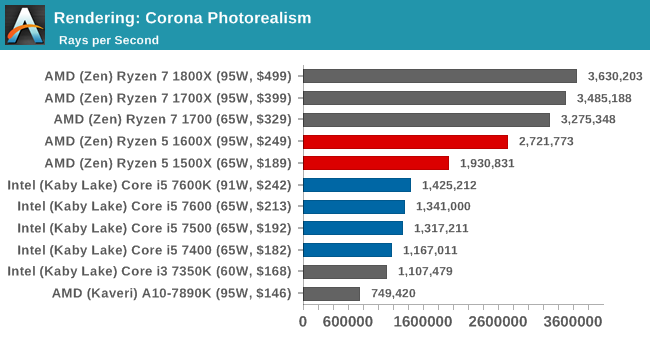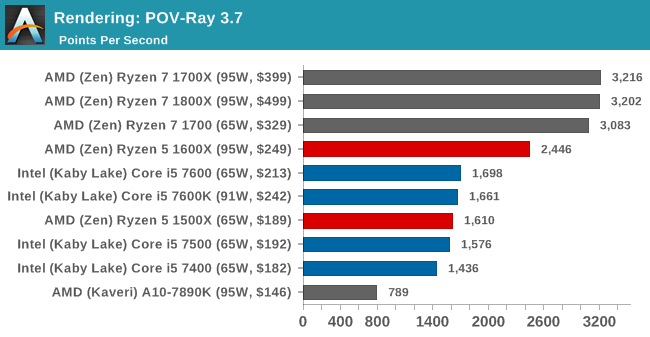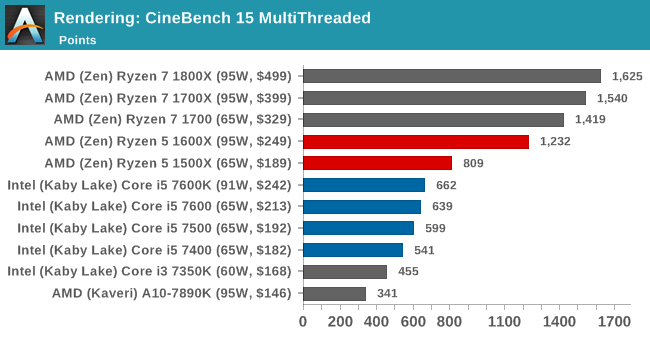The AMD Ryzen 5 1600X vs Core i5 Review: Twelve Threads vs Four at $250
by Ian Cutress on April 11, 2017 9:00 AM ESTBenchmarking Performance: CPU Rendering Tests
Rendering tests are a long-time favorite of reviewers and benchmarkers, as the code used by rendering packages is usually highly optimized to squeeze every little bit of performance out. Sometimes rendering programs end up being heavily memory dependent as well - when you have that many threads flying about with a ton of data, having low latency memory can be key to everything. Here we take a few of the usual rendering packages under Windows 10, as well as a few new interesting benchmarks.
Corona 1.3
Corona is a standalone package designed to assist software like 3ds Max and Maya with photorealism via ray tracing. It's simple - shoot rays, get pixels. OK, it's more complicated than that, but the benchmark renders a fixed scene six times and offers results in terms of time and rays per second. The official benchmark tables list user submitted results in terms of time, however I feel rays per second is a better metric (in general, scores where higher is better seem to be easier to explain anyway). Corona likes to pile on the threads, so the results end up being very staggered based on thread count.
Blender 2.78
For a render that has been around for what seems like ages, Blender is still a highly popular tool. We managed to wrap up a standard workload into the February 5 nightly build of Blender and measure the time it takes to render the first frame of the scene. Being one of the bigger open source tools out there, it means both AMD and Intel work actively to help improve the codebase, for better or for worse on their own/each other's microarchitecture.
POV-Ray 3.7.1
Another regular benchmark in most suites, POV-Ray is another ray-tracer but has been around for many years. It just so happens that during the run up to AMD's Ryzen launch, the code base started to get active again with developers making changes to the code and pushing out updates. Our version and benchmarking started just before that was happening, but given time we will see where the POV-Ray code ends up and adjust in due course.
Cinebench R15
The latest version of CineBench has also become one of those 'used everywhere' benchmarks, particularly as an indicator of single thread performance. High IPC and high frequency gives performance in ST, whereas having good scaling and many cores is where the MT test wins out.















254 Comments
View All Comments
802Shaun - Tuesday, April 11, 2017 - link
Just a friendly correction: It should be "200% more threads" instead of 300% more. Thanks for the article!Ian Cutress - Tuesday, April 11, 2017 - link
Updated :)ChristopherF - Tuesday, April 11, 2017 - link
Wouldn't 300% be correct since 12 is 3x 4?mickulty - Tuesday, April 11, 2017 - link
It has 300% of the threads, but has 200% *more* threads.buri - Tuesday, April 11, 2017 - link
Your logic is correct if you say "3 times", but with percentages you always refer to the % amount more. In this case is 8 threads more, so 200% of 4 threads. 6 threads more would have been 150% more, and so onMobiusPizza - Tuesday, April 11, 2017 - link
It's either 200% MORE threads or 300% the original thread count.ddriver - Tuesday, April 11, 2017 - link
Nice to see AMD not only back in the game, being competitive in trivial computing workloads, but also offering TWICE the value where PERFORMANCE really MATTERS - rendering, encoding, compiling and other time intensive workloads.MajGenRelativity - Tuesday, April 11, 2017 - link
Indeed it is. I recently built a PC with a 1700X, and my friend said it was a massive improvement over his old FX 6350SquarePeg - Tuesday, April 11, 2017 - link
I'm wondering how low AMD's pricing will go on R3 chip's if they can bring a 4C/4T low end R3 to market for $99 that can overclock decently then the FX 6300/6350 will have a true successor.MajGenRelativity - Tuesday, April 11, 2017 - link
That's also something I'm interested in. Right now it reaches down to $170, which is still in the upper mid-range, but if it can go even further down, I'd be pretty happy with it.